MITSUBISHI SHOGUN 2008 Owner's Manual (in English)
Manufacturer: MITSUBISHI, Model Year: 2008, Model line: SHOGUN, Model: MITSUBISHI SHOGUN 2008Pages: 538, PDF Size: 25.09 MB
Page 201 of 538
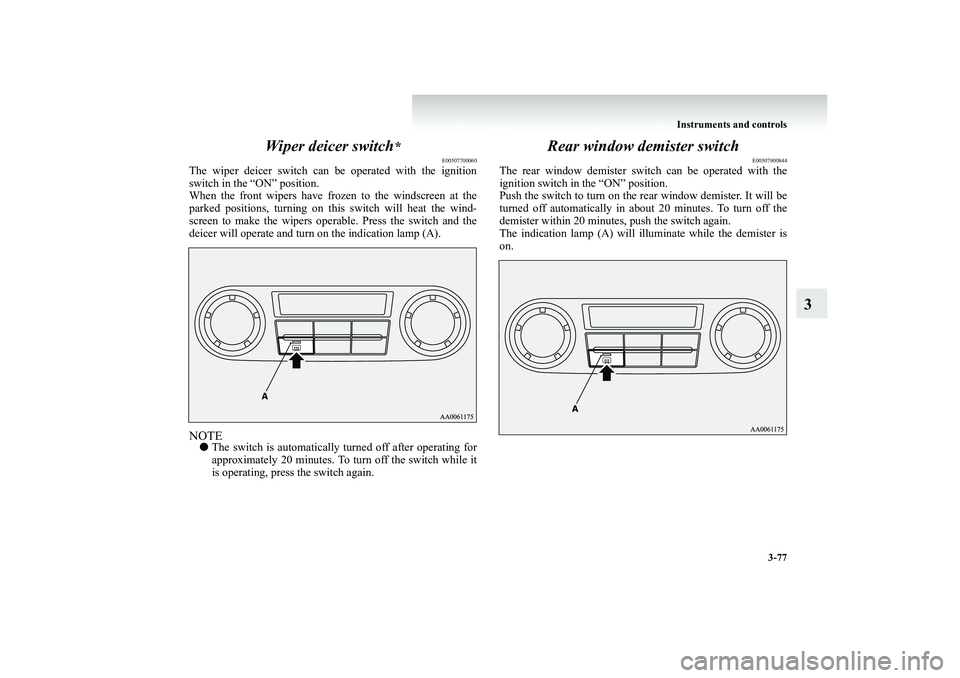
Instruments and controls
3-77
3
Wiper deicer switch
*
E00507700060
The wiper deicer switch can be
operated with the ignition
switch in the “ON” position. When the front wipers have fro
zen to the windscreen at the
parked positions, turning on this switch will heat the wind- screen to make the wipers oper
able. Press the switch and the
deicer will operate and turn on the indication lamp (A).NOTE●
The switch is automatically turned off after operating for approximately 20 minutes. To turn off the switch while it is operating, press the switch again.
Rear window demister switch
E00507900844
The rear window demister switch can be operated with the ignition switch in the “ON” position. Push the switch to turn on the rear window demister. It will beturned off automatically in about 20 minutes. To turn off the demister within 20 minutes, push the switch again. The indication lamp (A) will ill
uminate while the demister is
on.
BK-BK2008E1ENUK.en-uk-Section6.fm Page
77 Wednesday, January 9, 2008 4:32 PM
Page 202 of 538
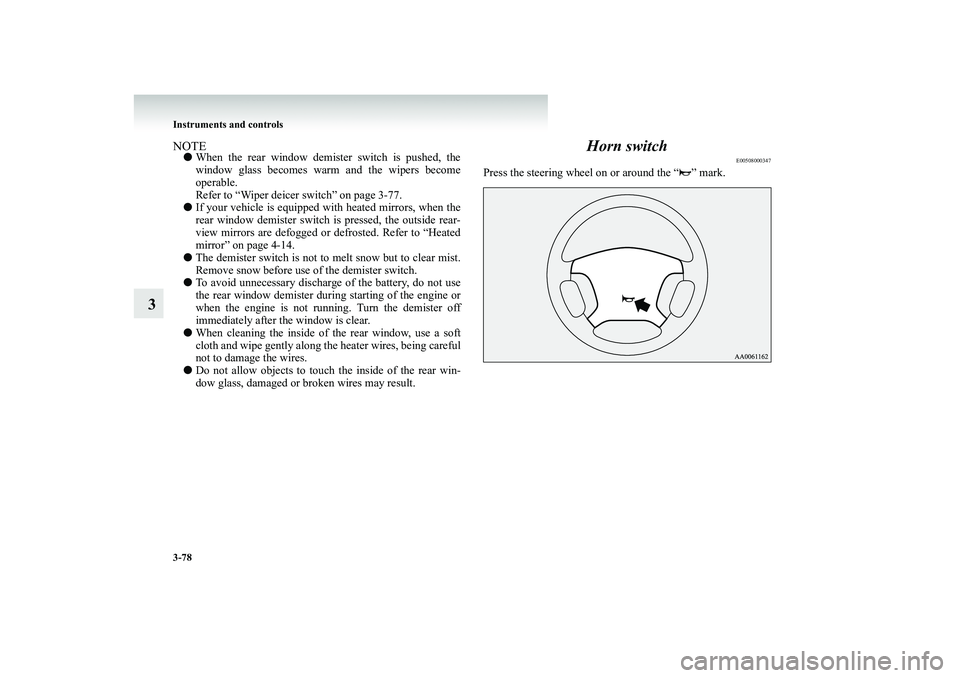
3-78 Instruments and controls
3
NOTE●
When the rear window demist
er switch is pushed, the
window glass becomes warm and the wipers become operable. Refer to “Wiper deicer switch” on page 3-77.
●
If your vehicle is equipped
with heated mirrors, when the
rear window demister switch is
pressed, the outside rear-
view mirrors are defogged or
defrosted. Refer to “Heated
mirror” on page 4-14.
●
The demister switch is not to melt snow but to clear mist. Remove snow before use of the demister switch.
●
To avoid unnecessary discharge
of the battery, do not use
the rear window demister duri
ng starting of the engine or
when the engine is not running. Turn the demister offimmediately after the window is clear.
●
When cleaning the inside of
the rear window, use a soft
cloth and wipe gently along the heater wires, being carefulnot to damage the wires.
●
Do not allow objects to touch
the inside of the rear win-
dow glass, damaged or broken wires may result.
Horn switch
E00508000347
Press the steering wheel on or around the “ ” mark.
BK-BK2008E1ENUK.en-uk-Section6.fm Page
78 Wednesday, January 9, 2008 4:32 PM
Page 203 of 538
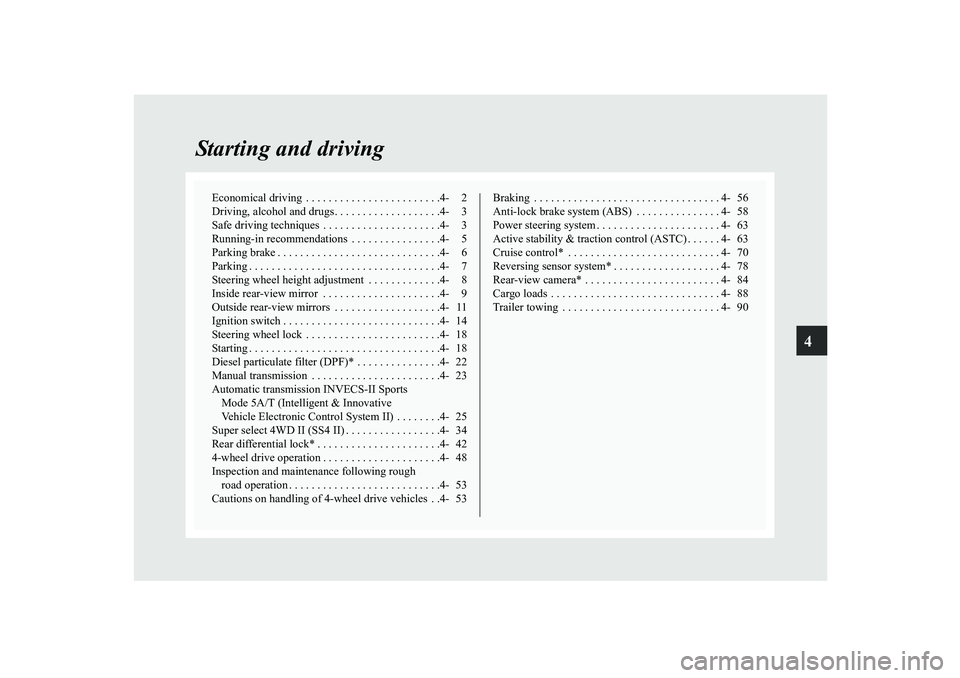
4
Starting and driving
Economical driving . . . . . . . . . . . . . . . . . . . . . . . .4- 2 Driving, alcohol and drugs. . . . . . . . . . . . . . . . . . .4- 3Safe driving techniques . . . . . . . . . . . . . . . . . . . . .4- 3Running-in recommendations . . . . . . . . . . . . . . . .4- 5Parking brake . . . . . . . . . . . . . . . . . . . . . . . . . . . . .4- 6Parking . . . . . . . . . . . . . . . . . . . . . . . . . . . . . . . . . .4- 7Steering wheel height adjustment . . . . . . . . . . . . .4- 8Inside rear-view mirror . . . . .
. . . . . . . . . . . . . . . .4- 9
Outside rear-view mirrors . . . . . . . . . . . . . . . . . . .4- 11Ignition switch . . . . . . . . . . . . . . . . . . . . . . . . . . . .4- 14Steering wheel lock . . . . . . . . . . . . . . . . . . . . . . . .4- 18Starting . . . . . . . . . . . . . . . . . . . . . . . . . . . . . . . . . .4- 18Diesel particulate filter (DPF)* . . . . . . . . . . . . . . .4- 22Manual transmission . . . . . . . . . . . . . . . . . . . . . . .4- 23Automatic transmission INVECS-II Sports Mode 5A/T (Intelligent & Innovative Vehicle Electronic Control Syst
em II) . . . . . . . .4- 25
Super select 4WD II (SS4 II) . . . . . . . . . . . . . . . . .4- 34Rear differential lock* . . . . . . . . . . . . . . . . . . . . . .4- 424-wheel drive operation . . . . . . . . . . . . . . . . . . . . .4- 48Inspection and maintenance following rough road operation . . . . . . . . . . . . . . . . . . . . . . . . . . .4- 53Cautions on handling of 4-wheel drive vehicles . .4- 53
Braking . . . . . . . . . . . . . . . . . . . . . . . . . . . . . . . . . 4- 56 Anti-lock brake system (ABS) . . . . . . . . . . . . . . . 4- 58Power steering system . . . . . . . . . . . . . . . . . . . . . . 4- 63Active stability & traction control (ASTC) . . . . . . 4- 63Cruise control* . . . . . . . . . . . . . . . . . . . . . . . . . . . 4- 70Reversing sensor system* . . . . . . . . . . . . . . . . . . . 4- 78Rear-view camera* . . . . . . . . . . . . . . . . . . . . . . . . 4- 84Cargo loads . . . . . . . . . . . . . . . . . . . . . . . . . . . . . . 4- 88Trailer towing . . . . . . . . . . . . . . . . . . . . . . . . . . . . 4- 90
BK-BK2008E1ENUK.en-uk-Section7.fm Page 1 Wednesday, January 9, 2008 4:36 PM
Page 204 of 538
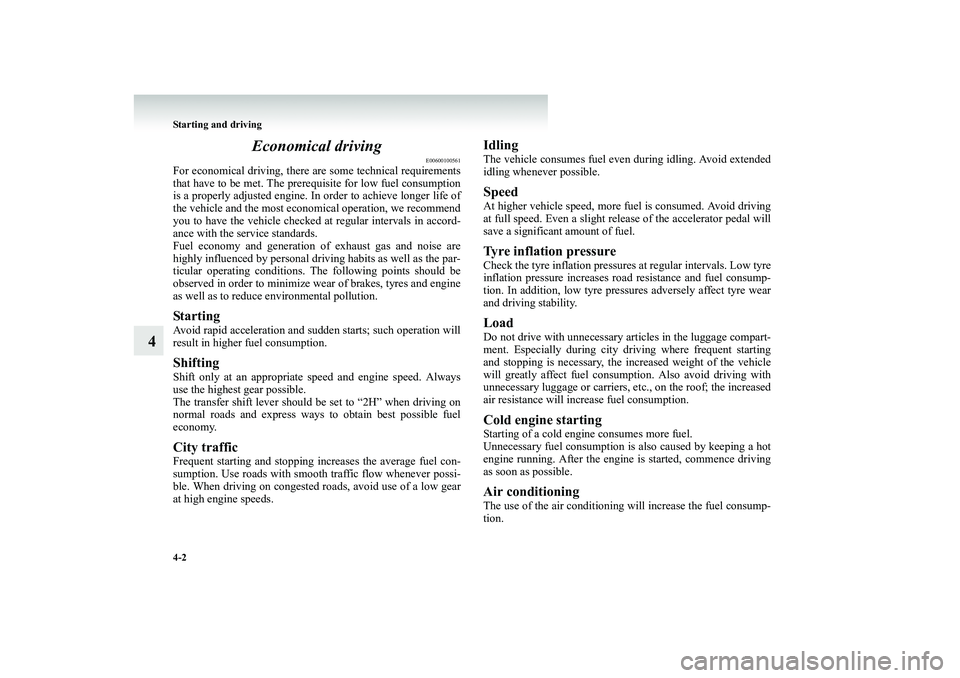
4-2 Starting and driving
4
Economical driving
E00600100561
For economical driving, there ar
e some technical requirements
that have to be met. The prerequisite for low fuel consumption is a properly adjusted engine. In order to achieve longer life ofthe vehicle and the most econo
mical operation, we recommend
you to have the vehicle checked
at regular intervals in accord-
ance with the service standards.Fuel economy and generation of exhaust gas and noise are highly influenced by personal driving habits as well as the par- ticular operating conditions. The following points should beobserved in order to minimize w
ear of brakes, tyres and engine
as well as to reduce environmental pollution.StartingAvoid rapid acceleration and sudden starts; such operation will result in higher fuel consumption.ShiftingShift only at an appropriate
speed and engine speed. Always
use the highest gear possible. The transfer shift lever should be set to “2H” when driving on normal roads and express ways to obtain best possible fueleconomy.City trafficFrequent starting and stopping
increases the average fuel con-
sumption. Use roads with smooth
traffic flow whenever possi-
ble. When driving on congested
roads, avoid use of a low gear
at high engine speeds.
IdlingThe vehicle consumes fuel even during idling. Avoid extended idling whenever possible.SpeedAt higher vehicle speed, more fu
el is consumed. Avoid driving
at full speed. Even a slight re
lease of the accelerator pedal will
save a significant amount of fuel.Tyre inflation pressureCheck the tyre inflation pressure
s at regular intervals. Low tyre
inflation pressure increases ro
ad resistance and fuel consump-
tion. In addition, low tyre pres
sures adversely affect tyre wear
and driving stability.LoadDo not drive with unnecessary articles in the luggage compart- ment. Especially during city dr
iving where frequent starting
and stopping is necessary, the increased weight of the vehicle will greatly affect fuel consumption. Also avoid driving with unnecessary luggage or carriers,
etc., on the roof; the increased
air resistance will increase fuel consumption.Cold engine startingStarting of a cold engine consumes more fuel. Unnecessary fuel consumption
is also caused by keeping a hot
engine running. After the engine is started, commence driving as soon as possible.Air conditioningThe use of the air conditioning
will increase the fuel consump-
tion.
BK-BK2008E1ENUK.en-uk-Section7.fm Page 2 Wednesday, January 9, 2008 4:36 PM
Page 205 of 538
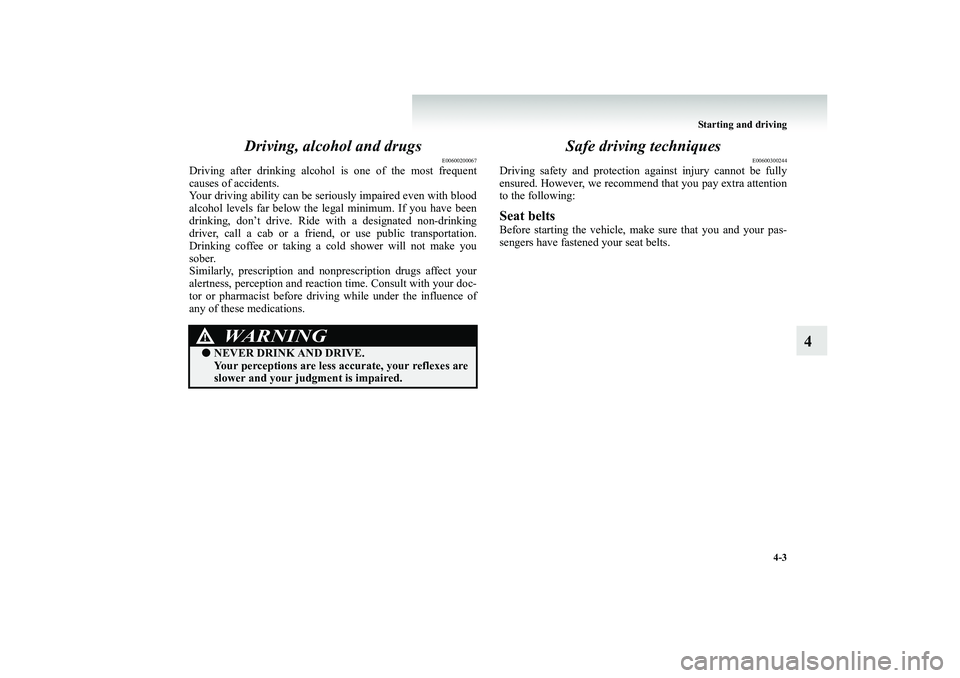
Starting and driving
4-3
4
Driving, alcohol and drugs
E00600200067
Driving after drinking alcohol is one of the most frequent causes of accidents. Your driving ability can be seriously impaired even with bloodalcohol levels far below the legal minimum. If you have been drinking, don’t drive. Ride with a designated non-drinking driver, call a cab or a friend,
or use public transportation.
Drinking coffee or taking a cold shower will not make you sober. Similarly, prescription and nonprescription drugs affect youralertness, perception and reacti
on time. Consult with your doc-
tor or pharmacist before driving while under the influence of any of these medications.
Safe driving techniques
E00600300244
Driving safety and protection against injury cannot be fully ensured. However, we recommen
d that you pay extra attention
to the following:Seat beltsBefore starting the vehicle, make sure that you and your pas-sengers have fastened your seat belts.
WARNING
!●
NEVER DRINK AND DRIVE. Your perceptions are less accurate, your reflexes areslower and your judgme
nt is impaired.
BK-BK2008E1ENUK.en-uk-Section7.fm Page 3 Wednesday, January 9, 2008 4:36 PM
Page 206 of 538
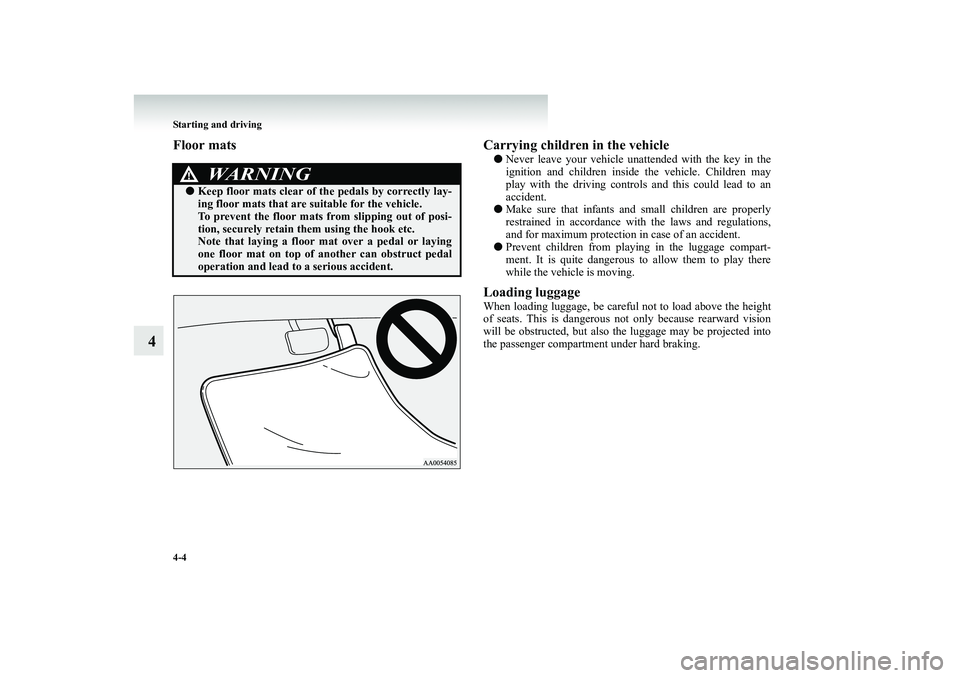
4-4 Starting and driving
4
Floor mats Carrying children in the vehicle
●
Never leave your vehicle unattended with the key in the ignition and children inside the vehicle. Children mayplay with the driving controls
and this could lead to an
accident.
●
Make sure that infants and small children are properly restrained in accordance with the laws and regulations, and for maximum protection
in case of an accident.
●
Prevent children fr
om playing in the luggage compart-
ment. It is quite dangerous to allow them to play there while the vehicle is moving.
Loading luggageWhen loading luggage, be careful not to load above the height of seats. This is dangerous no
t only because rearward vision
will be obstructed, but also the luggage may be projected into the passenger compartment under hard braking.
WARNING
!●
Keep floor mats clear of th
e pedals by correctly lay-
ing floor mats that are suitable for the vehicle. To prevent the floor mats from slipping out of posi- tion, securely retain th
em using the hook etc.
Note that laying a floor mat over a pedal or laying one floor mat on top of an
other can obstruct pedal
operation and lead to a serious accident.
BK-BK2008E1ENUK.en-uk-Section7.fm Page 4 Wednesday, January 9, 2008 4:36 PM
Page 207 of 538
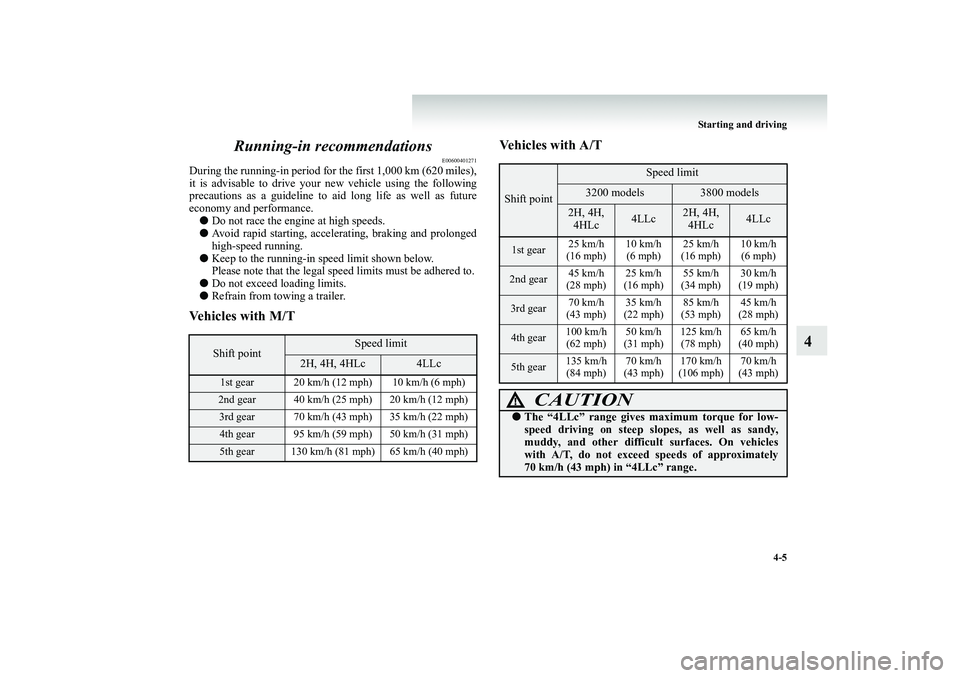
Starting and driving
4-5
4
Running-in recommendations
E00600401271
During the running-in period for the first 1,000 km (620 miles), it is advisable to drive your new vehicle using the following precautions as a guideline to aid
long life as well as future
economy and performance. ●
Do not race the engine at high speeds.
●
Avoid rapid starting, accelerat
ing, braking and prolonged
high-speed running.
●
Keep to the running-in speed limit shown below. Please note that the legal speed limits must be adhered to.
●
Do not exceed loading limits.
●
Refrain from towing a trailer.
Vehicles with M/T
Vehicles with A/T
Shift point
Speed limit
2H, 4H, 4HLc
4LLc
1st gear 20 km/h (12 mph) 10 km/h (6 mph)2nd gear 40 km/h (25 mph) 20 km/h (12 mph)3rd gear 70 km/h (43 mph) 35 km/h (22 mph)4th gear 95 km/h (59 mph) 50 km/h (31 mph)5th gear 130 km/h (81 mph) 65 km/h (40 mph)
Shift point
Speed limit
3200 models
3800 models
2H, 4H, 4HLc
4LLc
2H, 4H, 4HLc
4LLc
1st gear
25 km/h (16 mph)
10 km/h (6 mph)
25 km/h (16 mph)
10 km/h (6 mph)
2nd gear
45 km/h (28 mph)
25 km/h (16 mph)
55 km/h (34 mph)
30 km/h (19 mph)
3rd gear
70 km/h (43 mph)
35 km/h (22 mph)
85 km/h (53 mph)
45 km/h (28 mph)
4th gear
100 km/h (62 mph)
50 km/h (31 mph)
125 km/h (78 mph)
65 km/h (40 mph)
5th gear
135 km/h (84 mph)
70 km/h (43 mph)
170 km/h (106 mph)
70 km/h (43 mph)
CAUTION
!●
The “4LLc” range gives maximum torque for low- speed driving on steep slopes, as well as sandy, muddy, and other difficul
t surfaces. On vehicles
with A/T, do not exceed
speeds of approximately
70 km/h (43 mph) in “4LLc” range.
BK-BK2008E1ENUK.en-uk-Section7.fm Page 5 Wednesday, January 9, 2008 4:36 PM
Page 208 of 538
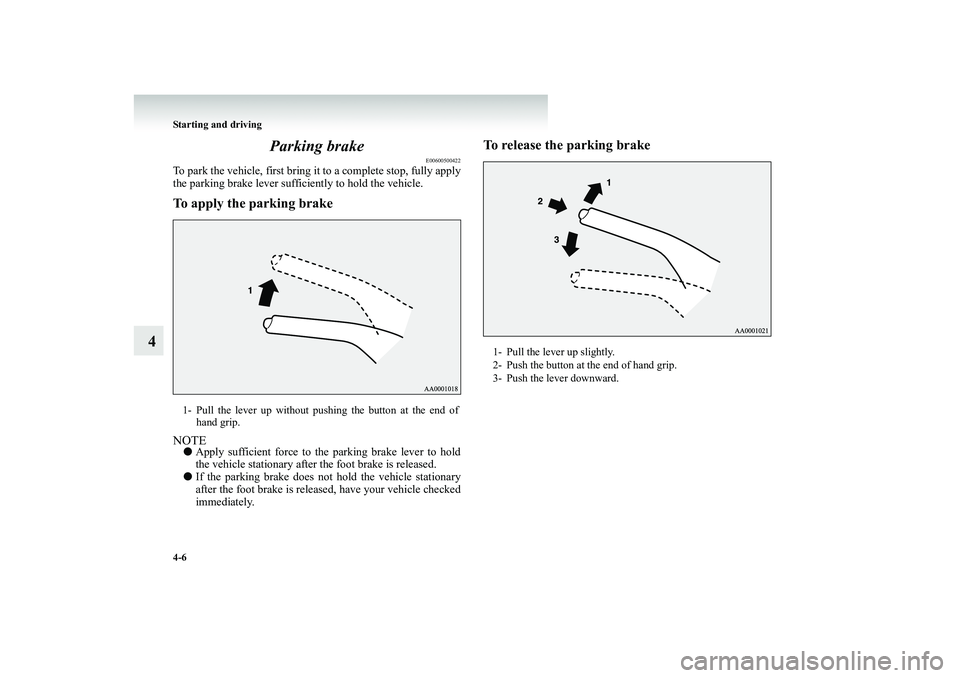
4-6 Starting and driving
4
Parking brake
E00600500422
To park the vehicle, first bring it to a complete stop, fully apply the parking brake lever sufficiently to hold the vehicle.To apply the parking brakeNOTE●
Apply sufficient force to the parking brake lever to hold the vehicle stationary after
the foot brake is released.
●
If the parking brake does not hold the vehicle stationary after the foot brake is releas
ed, have your vehicle checked
immediately.
To release the parking brake
1- Pull the lever up without pushing the button at the end of
hand grip.
1- Pull the lever up slightly. 2- Push the button at the end of hand grip. 3- Push the lever downward.
BK-BK2008E1ENUK.en-uk-Section7.fm Page 6 Wednesday, January 9, 2008 4:36 PM
Page 209 of 538
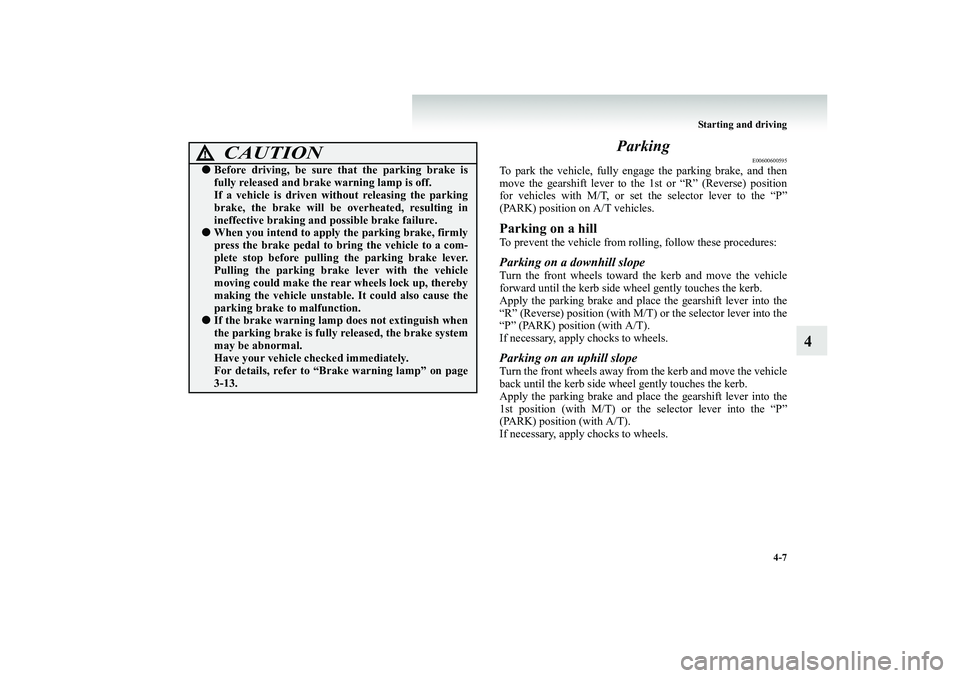
Starting and driving
4-7
4
Parking
E00600600595
To park the vehicle, fully enga
ge the parking
brake, and then
move the gearshift lever to th
e 1st or “R” (Reverse) position
for vehicles with M/T, or set
the selector lever to the “P”
(PARK) position on A/T vehicles.Parking on a hillTo prevent the vehicle from rolling, follow these procedures:Parking on a downhill slopeTurn the front wheels toward the kerb and move the vehicleforward until the kerb side wheel gently touches the kerb.Apply the parking brake and place
the gearshift lever into the
“R” (Reverse) position (with M/T) or the selector lever into the “P” (PARK) position (with A/T).If necessary, apply chocks to wheels.Parking on an uphill slopeTurn the front wheels away from
the kerb and move the vehicle
back until the kerb side wheel gently touches the kerb.Apply the parking brake and place
the gearshift lever into the
1st position (with M/T) or the selector lever into the “P” (PARK) position (with A/T).If necessary, apply chocks to wheels.
CAUTION
!●
Before driving, be sure that the parking brake is fully released and brake warning lamp is off.If a vehicle is driven wi
thout releasing the parking
brake, the brake will be
overheated, resulting in
ineffective brak
ing and possible brake failure.
●
When you intend to apply
the parking brake, firmly
press the brake pedal to bring the vehicle to a com- plete stop before pullin
g the parking brake lever.
Pulling the parking brake
lever with the vehicle
moving could make the rear
wheels lock up, thereby
making the vehicle unstable.
It could also cause the
parking brake to malfunction.
●
If the brake warning lamp
does not extinguish when
the parking brake is fully released, the brake system may be abnormal. Have your vehicle checked immediately.For details, refer to “Bra
ke warning lamp” on page
3-13.
BK-BK2008E1ENUK.en-uk-Section7.fm Page 7 Wednesday, January 9, 2008 4:36 PM
Page 210 of 538
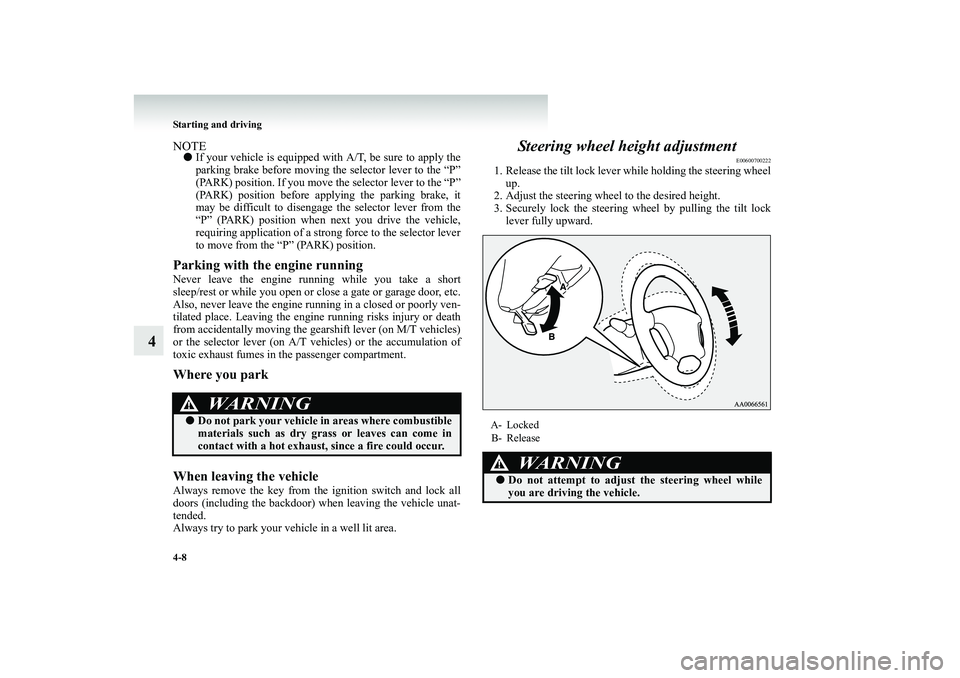
4-8 Starting and driving
4
NOTE●
If your vehicle is equipped with A/T, be sure to apply the parking brake before moving the selector lever to the “P” (PARK) position. If you move
the selector lever to the “P”
(PARK) position before applying the parking brake, itmay be difficult to disengage the selector lever from the “P” (PARK) position when next you drive the vehicle, requiring application of a strong force to the selector leverto move from the “P” (PARK) position.
Parking with the engine runningNever leave the engine running while you take a short sleep/rest or while you open or cl
ose a gate or garage door, etc.
Also, never leave the engine running in a closed or poorly ven-tilated place. Leaving the engine
running risks injury or death
from accidentally moving the g
earshift lever (on M/T vehicles)
or the selector lever (on A/T
vehicles) or the accumulation of
toxic exhaust fumes in the passenger compartment.Where you park When leaving the vehicleAlways remove the key from the ignition switch and lock all doors (including the backdoor) when leaving the vehicle unat- tended.Always try to park your vehicle in a well lit area.
Steering wheel height adjustment
E00600700222
1. Release the tilt lock lever
while holding the steering wheel
up.
2. Adjust the steering wheel
to the desired height.
3. Securely lock the steering wheel by pulling the tilt lock
lever fully upward.
WARNING
!●
Do not park your vehicle in
areas where combustible
materials such as dry grass or leaves can come incontact with a hot exhaust,
since a fire could occur.
A- Locked B- Release
WARNING
!●
Do not attempt to adjust
the steering wheel while
you are driving the vehicle.
BK-BK2008E1ENUK.en-uk-Section7.fm Page 8 Wednesday, January 9, 2008 4:36 PM